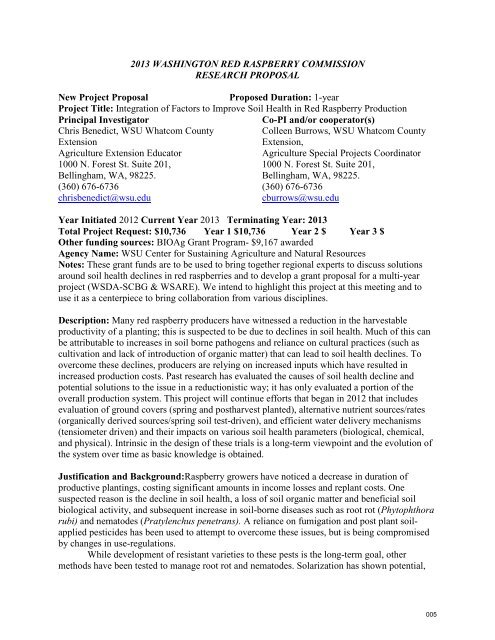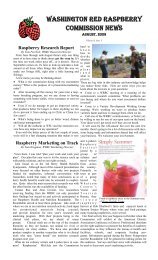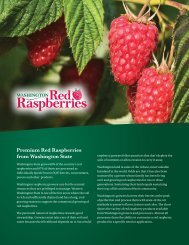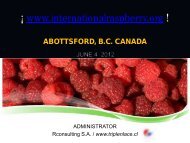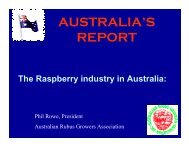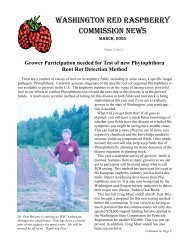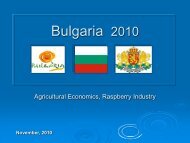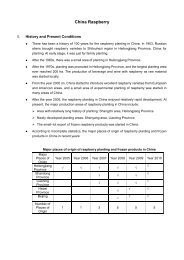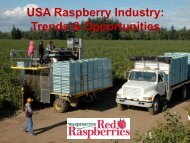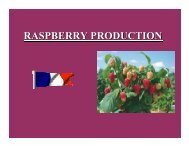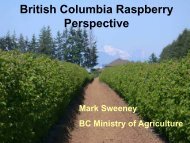2012 - Washington Red Raspberry Commission
2012 - Washington Red Raspberry Commission
2012 - Washington Red Raspberry Commission
You also want an ePaper? Increase the reach of your titles
YUMPU automatically turns print PDFs into web optimized ePapers that Google loves.
2013 WASHINGTON RED RASPBERRY COMMISSION<br />
RESEARCH PROPOSAL<br />
New Project Proposal<br />
Proposed Duration: 1-year<br />
Project Title: Integration of Factors to Improve Soil Health in <strong>Red</strong> <strong>Raspberry</strong> Production<br />
Principal Investigator<br />
Co-PI and/or cooperator(s)<br />
Chris Benedict, WSU Whatcom County Colleen Burrows, WSU Whatcom County<br />
Extension<br />
Extension,<br />
Agriculture Extension Educator<br />
Agriculture Special Projects Coordinator<br />
1000 N. Forest St. Suite 201,<br />
1000 N. Forest St. Suite 201,<br />
Bellingham, WA, 98225.<br />
Bellingham, WA, 98225.<br />
(360) 676-6736<br />
(360) 676-6736<br />
chrisbenedict@wsu.edu<br />
cburrows@wsu.edu<br />
Year Initiated <strong>2012</strong> Current Year 2013 Terminating Year: 2013<br />
Total Project Request: $10,736 Year 1 $10,736 Year 2 $ Year 3 $<br />
Other funding sources: BIOAg Grant Program- $9,167 awarded<br />
Agency Name: WSU Center for Sustaining Agriculture and Natural Resources<br />
Notes: These grant funds are to be used to bring together regional experts to discuss solutions<br />
around soil health declines in red raspberries and to develop a grant proposal for a multi-year<br />
project (WSDA-SCBG & WSARE). We intend to highlight this project at this meeting and to<br />
use it as a centerpiece to bring collaboration from various disciplines.<br />
Description: Many red raspberry producers have witnessed a reduction in the harvestable<br />
productivity of a planting; this is suspected to be due to declines in soil health. Much of this can<br />
be attributable to increases in soil borne pathogens and reliance on cultural practices (such as<br />
cultivation and lack of introduction of organic matter) that can lead to soil health declines. To<br />
overcome these declines, producers are relying on increased inputs which have resulted in<br />
increased production costs. Past research has evaluated the causes of soil health decline and<br />
potential solutions to the issue in a reductionistic way; it has only evaluated a portion of the<br />
overall production system. This project will continue efforts that began in <strong>2012</strong> that includes<br />
evaluation of ground covers (spring and postharvest planted), alternative nutrient sources/rates<br />
(organically derived sources/spring soil test-driven), and efficient water delivery mechanisms<br />
(tensiometer driven) and their impacts on various soil health parameters (biological, chemical,<br />
and physical). Intrinsic in the design of these trials is a long-term viewpoint and the evolution of<br />
the system over time as basic knowledge is obtained.<br />
Justification and Background:<strong>Raspberry</strong> growers have noticed a decrease in duration of<br />
productive plantings, costing significant amounts in income losses and replant costs. One<br />
suspected reason is the decline in soil health, a loss of soil organic matter and beneficial soil<br />
biological activity, and subsequent increase in soil-borne diseases such as root rot (Phytophthora<br />
rubi) and nematodes (Pratylenchus penetrans). A reliance on fumigation and post plant soilapplied<br />
pesticides has been used to attempt to overcome these issues, but is being compromised<br />
by changes in use-regulations.<br />
While development of resistant varieties to these pests is the long-term goal, other<br />
methods have been tested to manage root rot and nematodes. Solarization has shown potential,<br />
005


